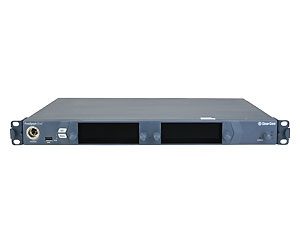Clear-com FSE-BASE Base Station for FreeSpeak Edge
Intercom
Clear-com FreeSpeak Edge Base Station is a
standalone 1RU device that provides extensive
connectivity to a wide
range of Clear-Com endpoints along with third-party Dante devices. Built
primarily to deploy 5 GHz transceivers and beltpacks, the base station also
provides support to FreeSpeak II splitters, 1.9 GHz E1 and IP
transceivers/beltpacks*, and 2.4 GHz E1 transceivers/beltpacks. The base
supports up to 6 IPT or FreeSpeak Edge (FSE) transceivers, up to 10 E1
transceivers (1.9 or 2.4GHz), and up to 100 channels. The base station also
provides multiple software-defined interoperable IP ports that support both
Dante and third-party devices. This third-party connection capability gives
the base station a wide powerful breadth of device coverage for professional
intercom users. .
Capacity
• Supports up to 6 IPT or FSE transceivers
and up to 10 E1 transceivers (1.9 or 2.4GHz)
• Supports up to 100
channels
Base Station
• Standard 1 rack unit (RU) device
•
High quality 12kHz audio to FS Edge beltpacks
• 2 large full-color
touch screen TFT displays
• 4 rotary encoders for gain and menu
operation
Headset connection
• Stage Announce
and Prog. Audio cable included
• Functions as PTP Leader Clock
Connectivity
• Wireless 5GHz Edge transceivers and
beltpacks
• Wireless 1.9GHz and 2.4GHz FSII splitters, transceivers
and beltpacks
• Dante enabled audio devices
• AES67 devices via
Dante controller
• 4-wire ports (8 ports RJ45)
• 2-wire ports (4
XLR-3F)
• GPIO (D-type 9 pin)
• LAN - 2 x RJ45, 2 x SFP
Configuration
• CCM browser-based configuration tool
• Direct management with encoders and display
• Capacity
Beltpacks per Base Station: 16 BPs
(FSII or FSE) Transceivers/Antennas Supported by Base: 6 x IPT or FSE
TCVR and 10 x E1 TCVRs (1.9 or 2.4GHz)
• Headset
Microphone Input
Input Type: Dynamic /Electret -
Selectable
Frequency Response: Headset Mic - Partyline: 200Hz –
12kHz + 3dBu
Frequency Response: Headset Mic - Line Out: 200Hz –
20kHz + 3dBu
Mic Limiter Threshold: -50dBu ±3dB
Mic
Limiter Range: = 20dB
Max Input Level: -25dBu
Input Level:
-60dBu nominal; -25dBu MAX
Headset Mic Voltage: 5V (Electret
selectable)
• Headset Output
Load
Impedance: > 32O
Output Impedance: 33O
Max Output Level
before Distortion: > 13dBu
Total Harmonic Distortion (THD): <
0.1% THD at 1kHz
Headset Mic - Partyline: -78dBu (Clear-Com mode)
Headset Mic - Line Out: -60dBu
Frequency Response: Partyline
- Headset Out: 200Hz – 10kHz + 3dBu
• Audio/Radio
4-wire I/O: Output Impedance >10kO, Input Impedance 200O + 10%,
transformer isolated balanced input and output.
4-wire Operating
Levels: 0dBu Nominal, 18dBu headroom
2-wire I/O: Selectable RTS
or Clear-Com mode, Software controlled auto-null, null depth >60dB at
1kHz
2-wire Operating Levels: -18dBu nominal (Clear-Com Mode),
-12dBu nominal (RTS Mode), Headroom 18dB
Frequency Response
Base-to-Beltpack:
Freespeak Edge Beltpack: 200Hz – 12kHz
Freespeak II Beltpack: 200Hz – 7.1kHz
• Partyline I/O
2W Power On/Off: A/B, C/D paired- software controlled
2W
Output Voltage: 25 – 28V DC, 560 mA per pair (A/B or C/D)
2W
Impedance: >10kO
2W Frequency Response: 200 to 12kHz. ±3dB
2W Total Harmonic Distortion (THD): < 0.1% THD at 1 kHz
• Relay Contacts or GPIO
Connector Type: 2 x DB9
Relay Contact Type: SPDT
Relay Quantity: 4
Relay
Contact Voltage Rating: 30V DC
Relay Contact Current Rating: 1A
Input Type: Opto-Isolated
Input Quantity: 2
Input
Voltage Range: 4 - 30 volts DC or AC
Input Current: >=1.2mA
required
• Connectors
4-wire I/O: (8)
RJ45
2-wire I/O: (4) XLR-3F
Program Input: XLR-3M,
provided using cable assembly CAB-RJ45-PGM-SA
Stage Announce
Output: XLR-3F, provided using cable assembly CAB-RJ45-PGM-SA
Headset: Freespeak Edge Base: 4-pin XLR-M, auto headset detect
USB: USB type A Receptacle
Number of E1 antenna ports: 2 x RJ45,
2 x Fiber (2 active at any time)
DECT Radio frequency sync: Rear
RJ45 input and output RF sync connectors
• Indicators and
Function
Displays: (2) 480 x 128 color TFT LED Touch
Screen displays
Front Panel Indicators & Function: (2) Power
Supply Status LEDs (1) Status LED (Edge) (1) Three Color Level Control
LED Array
Power: AC Mains input: 100-240V AC, 50-60Hz, 160W Max,
IEC60320 C14 inlet.
DC Low Voltage Input: 12V DC +/- 5%, 12A
External AC/DC Power Supply (453G020-1 Supplied):
Input:
100-240V AC, 50-60Hz, 2.2A Max, IEC60320 C14 inlet.
Output: 12V
DC +/- 5%, 12.5A
• Environmental
Operating: 32° to 113°F (0° to 45°C)
Storage: 86° to 158°F (30°
to 70°C)
Humidity: 20-90% Non-Condensing
•
Dimensions
1RU 19 x 1.72 x 13.929in (WxHxL)
(43.6
x 482.6 x 353.8mm)
Depth: 260mm
Weight: 7.25lbs (3.29kg)
• Network Specifications
AoIP Interfaces
Protocols: RTSP/SAP AES67 Dante
Audio Sampling: 24 bit Linear
48KHz
IP Addressing: Static, DHCP
Network Compatibility:
Layer 2 & 3 LAN only
Quality of Service: DiffServ RFC2474
IGMP: On (AoIP)
Multicast: On (AoIP)
Network Timing: PTPv2
(AoIP) / PTP v1 (Dante) Minimum Network Bandwidth Required
Perduplex Connection: 1 x FS II IPT bandwidth usage: ~7 Mbps.
1 x
FS Edge IPT: ~ 9.6 Mbps Network Protocols Ethernet IPv4 Unicast Audio
and Control mDNS–Multicast Device Discovery
• Network
Ports
Unicast:
Port 80 TCP–Web Interface, System
Management, Expansion
Port 443 for HTTPS
Port 6001
UDP–AES67 Data
Port 15000 – 15256 UDP – AES67 Audio
Multicast:
Port 5353 UDP–mDNS, Names, Discovery,
Linking, Expansion, Dante (through various ports)
Network Jitter
Tolerance: < 1us required for RF Syncing of Transceivers
• Recommended Ethernet Switches
Managed Ethernet Switch
– Layer 3 100/1000 Base-T ports for endpoints
1000 Base IP Trunks
between switches
QoS Configuration Energy Efficient Ethernet
bypass option
IGMP Snooping bypass option
|


